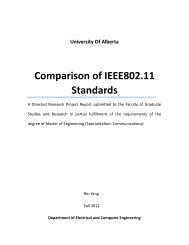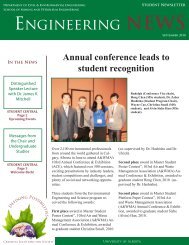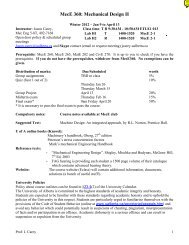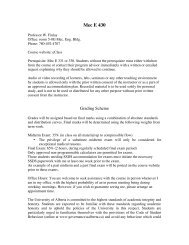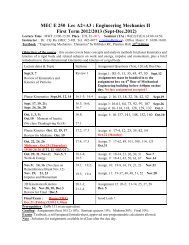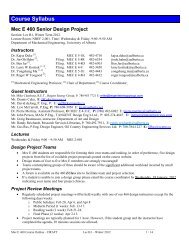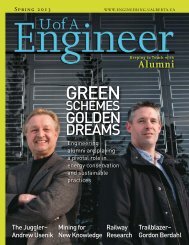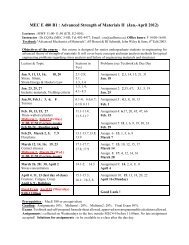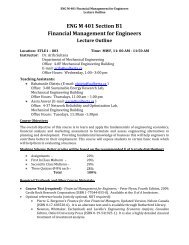Download - Faculty of Engineering - University of Alberta
Download - Faculty of Engineering - University of Alberta
Download - Faculty of Engineering - University of Alberta
You also want an ePaper? Increase the reach of your titles
YUMPU automatically turns print PDFs into web optimized ePapers that Google loves.
Edmonton artist Bill Miller, stricken<br />
with multiple sclerosis, used GPS and<br />
video game technology to participate<br />
in a golf competition staged by<br />
Marsden’s company, Madentec.<br />
ny’s innovations. By 1991 Madentec had<br />
developed the on-screen keyboard, which was<br />
licensed by Micros<strong>of</strong>t. The life <strong>of</strong> Marsden’s<br />
friend Si, the impetus and first benefactor <strong>of</strong><br />
his ideas, became more complete and productive.<br />
With the help <strong>of</strong> the technology, Si wrote<br />
a book about his life and gave public speeches.<br />
He was also able to move back home for<br />
the last three years <strong>of</strong> his life after years in a<br />
nursing home. Unfortunately, Si died <strong>of</strong> pneumonia<br />
in the mid-1990s.<br />
Currently, Madentec’s technology is used<br />
by about 20,000 individuals—including<br />
Seattle-based Steve Harper, a man with cerebral<br />
palsy who maintains Madentec’s company<br />
website. When he was 11, Harper learned<br />
Morse code. He used it to communicate by<br />
banging head switches, and was fortunate to<br />
have been given a Morse code communicator.<br />
In the ’90s, a company in the United States<br />
developed s<strong>of</strong>tware called Ke:nx that allowed<br />
users <strong>of</strong> Morse code to operate a computer.<br />
Ke:nx changed Harper’s life, but when the new<br />
generation <strong>of</strong> Macs—running OS X— came<br />
out, the s<strong>of</strong>tware was no longer compatible.<br />
Bill Miller<br />
“So I found out that Madentec bought the<br />
old Ke:nx technology,” Harper says by email.<br />
“I e-mailed Randy in 2004 and told him<br />
all about myself and I told him that I needed<br />
an updated Morse code system that would<br />
work on the Mac OS X. Quickly Randy and<br />
his brother found out how persistent I am.<br />
I wasn’t rude but I kept on e-mailing and<br />
e-mailing them.”<br />
A mutual friend (“with Randy’s blessing”)<br />
made a Morse code system for the Mac OS X.<br />
This year, Madentec is coming out with a<br />
commercial version <strong>of</strong> the Morse code for the<br />
Mac OS X, with more features. Harper finally<br />
met Marsden face-to-face in April 2007,<br />
when “really right out <strong>of</strong> the blue,” Marsden<br />
invited him to go on a cruise to Mexico with<br />
Madentec. During the cruise, Harper made a<br />
presentation on the great potential Morse<br />
code has for Madentec. A couple <strong>of</strong> months<br />
later, Harper e-mailed Marsden, asking him if<br />
he wanted help on the company website. He<br />
landed a job as Madentec’s webmaster.<br />
“I love the job,” Harper says. “With<br />
America’s economy basically down the toilet,<br />
Artist Bill Miller longed to use his power wheelchair as a paint<br />
brush. One morning as he and his wife Evelyn were leaving the<br />
house, Miller looked at his driveway, covered in snow. “What I saw<br />
before me was a 15 x 80-foot unbelievably white, virgin canvas,” he<br />
says. “My wheelchair was a new mid-wheel drive Quickie 424 that<br />
allowed me to turn a complete circle like I was on a turntable.<br />
Therefore I was able to turn complete circles without going over my<br />
tracks. As a result I ended up with a series <strong>of</strong> connecting circular<br />
patterns that were impossible for me to create any other way.”<br />
That morning’s work was the inspiration for The Chairbrush Project<br />
I and The Chairbrush Project II, a series <strong>of</strong> works based on images<br />
Miller created by wheeling through snow, and documented in<br />
photos taken by Evelyn. Miller uses computers to artistically build<br />
on the images.<br />
Miller has lost the use <strong>of</strong> his hands and without technology<br />
provided by Madentec, the artist’s creative voice would be silenced.<br />
At left: In the Eye <strong>of</strong> the Dragon, by Bill Miller.<br />
a lot <strong>of</strong> ‘able-bodied’ people are unfortunately<br />
unemployed. However, I’m employed.<br />
When I think about that, I just laugh in<br />
amazement.”<br />
Marsden talks a lot about how Madentec’s<br />
technology “just gives people their lives<br />
back.” Bill Miller is another example. Miller,<br />
an Edmonton visual artist and former industrial<br />
arts teacher, suffers from multiple sclerosis.<br />
As the disease progressed he lost use <strong>of</strong> his<br />
right hand, then his left. “When I met Randy<br />
in 1995, I was at a point in my life where as<br />
an artist I was left expressionless because at<br />
the time I had lost the use <strong>of</strong> both hands,” he<br />
says. Within a week <strong>of</strong> being outfitted with<br />
equipment that allows him to manipulate a<br />
cursor through head movements, Miller was<br />
back creating art on the computer. He now<br />
does it four or five hours per day. He has<br />
become part <strong>of</strong> an on-line network <strong>of</strong> likeminded<br />
colleagues and has delivered<br />
PowerPoint presentations at conferences.<br />
In 2000, Marsden thrilled Miller by inviting<br />
him to play in a special golf tournament<br />
at the famed Pelican Hill golf course in<br />
Spring 2009 U <strong>of</strong> A Engineer 17




